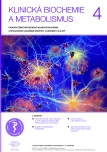Galectin-3 in cardiology
Authors:
A. Jabor 1,2; J. Franeková 1,2
Authors‘ workplace:
Oddělení klinické biochemie, Pracoviště laboratorních metod, Institut klinické a experimentální medicíny, Praha
1; Ústav imunologie a klinické biochemie, 3. lékařská fakulta Univerzity Karlovy, Praha
2
Published in:
Klin. Biochem. Metab., 30, 2022, No. 4, p. 105-110
Overview
Galectin-3 is mainly used in cardiology as a prognostic marker. Its pathophysiological effects correlate with the risk of cardiac fibrosis and remodelation. Elevated concentrations of galectin-3 in plasma (above the decision limit of 18 μg/L) increase the risk of cardiovascular morbidity and overall mortality, especially in patients with heart failure, myocardial infarction, heart transplantation and other cardiac diseases. The predictive value of galectin-3 increases when combined with natriuretic peptides. In cardiology, galectin-3 is recognized as a candidate molecule for prognostication.
Keywords:
myocardial infarction – heart failure – heart transplantation – Galectin-3
Sources
1. van Kimmenade, R. R., Januzzi, J. L. Jr., Ellinor, P. T., et al. Utility of amino-terminal pro-brain natriuretic peptide, galectin-3, and apelin for the evaluation of patients with acute heart failure. J Am. Coll. Cardiol., 2006, 48(6), s. 1217-1224.
2. Filipe, M. D., Meijers, W. C., Rogier van der Velde, A., de Boer, R. A. Galectin-3 and heart failure: prognosis, prediction & clinical utility. Clin. Chim. Acta, 2015, 30, 443, s. 48-56.
3. Suthahar, N., Meijers, W. C., Silljé, H. H. W., Ho, J. E., Liu, F. T., de Boer, R. A. Galectin-3 Activation and Inhibition in Heart Failure and Cardiovascular Disease: An Update. Theranostics, 2018, 8(3), s. 593-609.
4. Meijers, W. C., Bayes-Genis, A., Mebazaa, A., et al. Circulating heart failure biomarkers beyond natriuretic peptides: review from the Biomarker Study Group of the Heart Failure Association (HFA), European Society of Cardiology (ESC). Eur. J Heart. Fail., 2021, 23(10), s. 1610-1632.
5. Grübler, M. R., Delgado, G., Kleber, M., et al. Effect of Galectin 3 on Aldosterone-Associated Risk of Cardiovascular Mortality in Patients Undergoing Coronary Angiography. Am. J Cardiol., 2020, 127, s. 9-15.
6. Pozder Geb Gehlken, C., Rogier van der Velde, A., Meijers, W. C., et al. Pectins from various sources inhibit galectin-3-related cardiac fibrosis. Curr. Res. Transl. Med., 2022, 70(1), s. 103321.
7. van der Velde, A. R. Galectin-3 in heart failure: From biomarker to target for therapy. (Thesis), Rijksuniversiteit Groningen, 2017, ISBN 978-94-6169-998-5.
8. de Boer, R. A., van Veldhuisen, D. J., Gansevoort, R. T., et al. The fibrosis marker galectin-3 and outcome in the general population. J Intern. Med., 2012, 272(1), s. 55-64.
9. de Boer, R. A., Yu, L., van Veldhuisen, D. J. Galectin-3 in cardiac remodeling and heart failure. Curr. Heart. Fail. Rep., 2010, 7(1), s. 1-8. Erratum in: Curr. Heart. Fail. Rep., 2012, 9(3), s. 163.
10. Aleksova, A., Sinagra, G., Beltrami, A. P., et al. Biomarkers in the management of acute heart failure: state of the art and role in COVID-19 era. ESC Heart Fail., 2021, 8(6), s. 4465-4483.
11. Meijers, W. C., van der Velde, A. R., Ruifrok, W. P., et al. Renal handling of galectin-3 in the general population, chronic heart failure, and hemodialysis. J Am. Heart. Assoc., 2014, 3(5), e000962.
12. Demissei, B. G., Cotter, G., Prescott, M. F., et al. A multimarker multi-time point-based risk stratification strategy in acute heart failure: results from the RELAXAHF trial. Eur. J Heart. Fail., 2017, 19(8), s. 1001-1010.
13. Yancy, C. W., Jessup, M., Bozkurt, B., et al. 2013 ACCF/AHA guideline for the management of heart failure: a report of the American College of Cardiology Foundation/American Heart Association Task Force on Practice Guidelines. J Am. Coll. Cardiol., 2013, 62(16), e147-239.
14. Yancy, C. W., Jessup, M., Bozkurt, B., et al. 2017 ACC/AHA/HFSA Focused Update of the 2013 ACCF/ AHA Guideline for the Management of Heart Failure: A Report of the American College of Cardiology/American Heart Association Task Force on Clinical Practice Guidelines and the Heart Failure Society of America. J Am. Coll. Cardiol., 2017, 70(6), s. 776-803.
15. Heidenreich, P. A., Bozkurt, B., Aguilar, D., et al. 2022 AHA/ACC/HFSA Guideline for the Management of Heart Failure: Executive Summary: A Report of the American College of Cardiology/American Heart Association Joint Committee on Clinical Practice Guidelines. Circulation, 2022, 145(18), e876-e894.
16. Ponikowski, P., Voors, A. A., Anker, S. D., Bueno, H., Cleland, J. G., Coats, A. J., Falk, V., González - Juanatey, J. R., Harjola, V. P., Jankowska, E. A., et al. 2016 ESC Guidelines for the diagnosis and treatment of acute and chronic heart failure: The Task Force for the diagnosis and treatment of acute and chronic heart failure of the European Society of Cardiology (ESC). Developed with the special contribution of the Heart Failure Association (HFA) of the ESC. Eur. J Heart. Fail., 2016, 18(8), s. 891-975.
17. McDonagh, T. A., Metra, M., Adamo, M., et al. 2021 ESC Guidelines for the diagnosis and treatment of acute and chronic heart failure. Eur. Heart. J, 2021, 42(36), s. 3599-3726.
18. Asleh, R., Enriquez-Sarano, M., Jaffe, A. S., et al. Galectin-3 Levels and Outcomes After Myocardial Infarction: A Population-Based Study. J Am. Coll. Cardiol., 2019, 73(18), s. 2286-2295.
19. Grupper, A., Nativi-Nicolau, J., Maleszewski, J. J., et al. Circulating Galectin-3 Levels Are Persistently Elevated After Heart Transplantation and Are Associated With Renal Dysfunction. JACC Heart. Fail., 2016, 4(11), s. 847-856.
20. Franeková, J., Hošková, L., Sečník, P. Jr., et al. The role of timely measurement of galectin-3, NT-proBNP, cystatin C and hsTnT in predicting prognosis and heart function after heart transplantation. Clin. Chem. Lab. Med., 2016, 54(2), s. 339-344.
21. Franeková, J., Hošková, L., Jabor, A. Galectin-3 as an independent prognostic factor after heart transplantation. Clin. Transplant., 2022, 36(5), e14592.
Labels
Clinical biochemistry Nuclear medicine Nutritive therapistArticle was published in
Clinical Biochemistry and Metabolism

2022 Issue 4
Most read in this issue
- Serum amyloid A and its clinical significance
- 14-3-3 proteins and their clinical significance
- Budoucnost KBM od č.1/2023
- Determination of chlorides in serum by methods with ion-selective electrodes (ISE). Standardization without harmonization.
